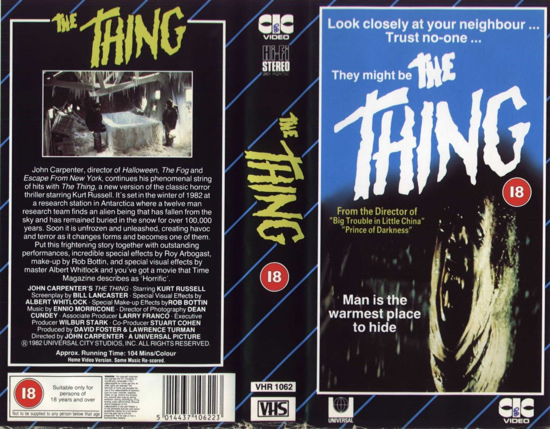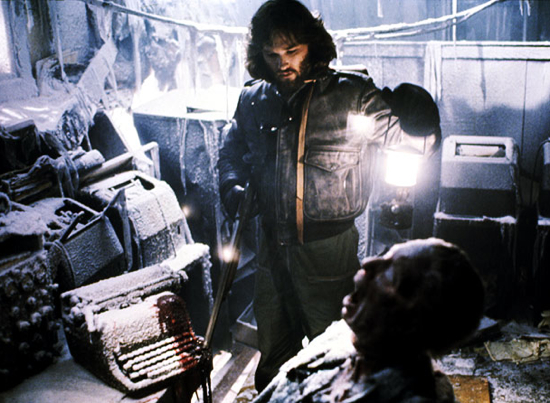It’s hard to believe but three decades have passed since John Carpenter unleashed his dark masterpiece The Thing on a sadly unappreciative world. Yet like all good art, with the passing of time, in the manner of fine wine, The Thing has progressively gained an appreciation as not only one of Carpenter’s, but one of cinema’s finest works.
One of Carpenter’s major inspirations is Hollywood legend Howard Hawks, whom he actually met while at film school. Not only was Assault On Precinct 13 inspired by Rio Bravo, but Carpenter edited the film under the pseudonym John T Chance, the character played by John Wayne in Hawks’ 1959 Western. It was natural that Carpenter would want to remake one of Hawks’ movies, namely The Thing From Another World (which he loved so much he included footage from it in Halloween). This 1951 sci-fi was credited to Christian Nyby, but the learned consensus is that producer Hawks called the shots.
In truth though, Carpenter’s The Thing is no remake at all, but rather a more faithful adaptation of John W Campbell’s source story, Who Goes There?, originally published in the magnificently titled Astounding Science-Fiction magazine. This 1938 novella tells the tale of a parasitic alien organism that infiltrates an Antarctic research station, and begins to assimilate and absorb the human (and canine) life forms there.
Carpenter would later refer to The Thing as the first part of what he terms his ‘Apocalypse Trilogy’ (followed by 1987’s Prince of Darkness and 1995’s In The Mouth Of Madness), all three featuring a threat that could engulf the entire world if it is not restrained by the protagonists (which is another Hawksian theme – that of a team that must pull together against the odds). It’s also interesting to note that Carpenter’s version owes something to They Bite, a potential screenplay developed with his Dark Star collaborator Dan O’Bannon, in which people are attacked by an insect-like organism which mimics its victims. (Said script also influenced O’Bannon’s work on Alien). And of course the idea of alien invaders imitating their victims previously drove Invaders From Mars, Invasion Of The Body Snatchers, It Came From Outer Space and The Quatermass Experiment.
While The Thing does star Carpenter regular Kurt Russell – almost the director’s alter ego in some respects – the ensemble largely comprises character actors, adding to its believability (there is none of the winking at the audience that mars so much horror). The only female presence is that of the chess computer that Russell’s MacReady plays. It’s tempting to see The Thing itself as the female character, giving birth to a multitude of life. Interestingly the crew, bar one pregnant member who had to leave for that very reason, was also male. (By way of contrast, Matthijs van Heijningen Jr’s 2011 prequel, also titled The Thing – which I feel made a lot of effort to stay faithful to Carpenter’s work – features a strong female lead who works well in the context of the story.)
Characterisation is not overt here (it’s achieved in a subtle way, through action rather than dialogue), the emphasis being on the protagonists’ response to their situation and loss of humanity. The inability to distinguish the human from the monstrous goes all the way back to Dr Jekyll And Mr Hyde. In the Hawks/Nyby flick, it’s all about how the group pulls together to survive. Carpenter’s vision is all about how humans pull away from each other, how isolated they already are… and this is before the horror begins (loss of self-identity is the ultimate horror as it is universal). They are already bored with each other’s company, isolated, some disappearing into a fog of alcohol or drugs to escape the ennui. This has a lot in common with the world of Carpenter’s cult classic Dark Star – plus in both pictures a mechanical voice is the closest we get to a female character. Our heroes might as well be in outer space anyway, so isolated have they become. Clark (Richard Masur) is already more connected to the dogs than his fellow men.
While The Thing From Another World boats a man in a suit, Carpenter enlisted visual effects maestro Rob Bottin to exploit the possibilities of a creature that can imitate all the life forms it has come into contact with. (Bottin had previously worked on The Fog, creating the look of the undead lepers, and indeed played their ghostly leader Blake). Carpenter trusted Bottin implicitly, and didn’t know until the last minute what forms The Thing would finally take. Bottin worked himself hard, seven days a week, living on candy bars and fizzy drinks, ending up in hospital with nervous exhaustion. (The late, great Stan Winston created the Dog-Thing to give Bottin some breathing space). The results are spectacular and have never dated, while the CGI that infests modern cinema dates very quickly as the more we see of it, the more easily we identify that it has no three-dimensional reality.
The Thing‘s screenplay, written by Bill Lancaster (son of Burt), was taut and, as they say, on the money. Location shooting took place near the town of Stewart in British Columbia. Interior filming was as severe on cast and crew as the exteriors, consisting as it did of several weeks of shooting on artificially frozen sound stages in Los Angeles.
Given the theme of imitation, it’s fitting that the man hired to provide the score – the legendary Ennio Morricone – appears to have imitated Carpenter. (There’s a touch of Bernard Herrmann in there too.) Carpenter told biographer Gilles Boulenger: "Ennio is one of my favourite composers. He is a hero of mine. He had written several pieces for The Thing, and I told him that he was using too many notes for the title track and that he should simplify it. He did simplify it, and the title track that you hear is his. He did all the orchestrations and recorded for me twenty minutes of music I could use wherever I wished but without seeing any footage. I cut his music into the film and realised that there were places, mostly scenes of tension, in which his music would not work. Since we need something, I secretly ran off and recorded in a couple of days a few pieces to use. My pieces were very simple electronic pieces – it was almost tones. It was not really music at all but just background sound effects. I used these pieces as unifying moments because structurally we had to redo The Thing at one point in the centre. I put them in there to glue together the film, but in no way was I trying to compete with Ennio’s score. This score is his."
The movie can be read on multiple levels. One interpretation I favour is that imitation is more and more prevalent in our media-saturated world, where people imitate their idols and hang onto every vacuous tweet. Identity too, has continued to be a theme in Carpenter’s work, in They Live for instance. Trust too, or lack of it, is an ongoing concern. At one point MacReady wearily tells his audio log (and the fact that he can only confide to a machine speaks volumes and is something far too many of us do today), "Nobody trusts anybody now." It doesn’t come any harsher or blunter than that. Nigel Kneale is also a big influence: the Martians are hidden among us in Quatermass And The Pit, buried deep in our subconscious.
On release The Thing performed below Universal Studio’s expectations. Various reasons are given, for example the fact that the kind of sci-fi audiences wanted was E.T., featuring a slightly more friendly alien. Carpenter was crushed, and moreover, sacked from his next assignment, helming an adaptation of Stephen King’s Firestarter. While the director continued to do good work, his career was never the same again. The Thing was Carpenter’s first production under a major studio, and it made his future working relationship with the executives uneasy.
In 2008 he told Time Out New York: "I take every failure hard. The one I took the hardest was The Thing. My career would have been different if that had been a big hit… The movie was hated. Even by science-fiction fans. They thought that I had betrayed some kind of trust, and the piling on was insane. Even the original movie’s director, Christian Nyby, was dissing me."

Like all good art The Thing has eventually found the audience it always deserved. Earlier this year, Time Out‘s 100 Best Horror Films poll of directors, actors and genre experts placed the picture at number six – two spots ahead of Halloween. Amusingly, it is viewed at the start of each winter by the staff of the Amundsen-Scott South Pole Station, often as a double feature with The Shining (which is really tempting fate – like a group of campers watching Ravenous before heading for the hills).
The final verdict belongs to John Carpenter himself, who told Gilles Boulenger: "As I have gotten further from The Thing, I stopped worrying about how painful that whole experience was. I put it in its place now. I love the movie a great deal… It’s my favourite film of my own."
The Thing screens on Saturday October 20 at the Prince Charles Cinema in London, as part of a John Carpenter All Nighter.



